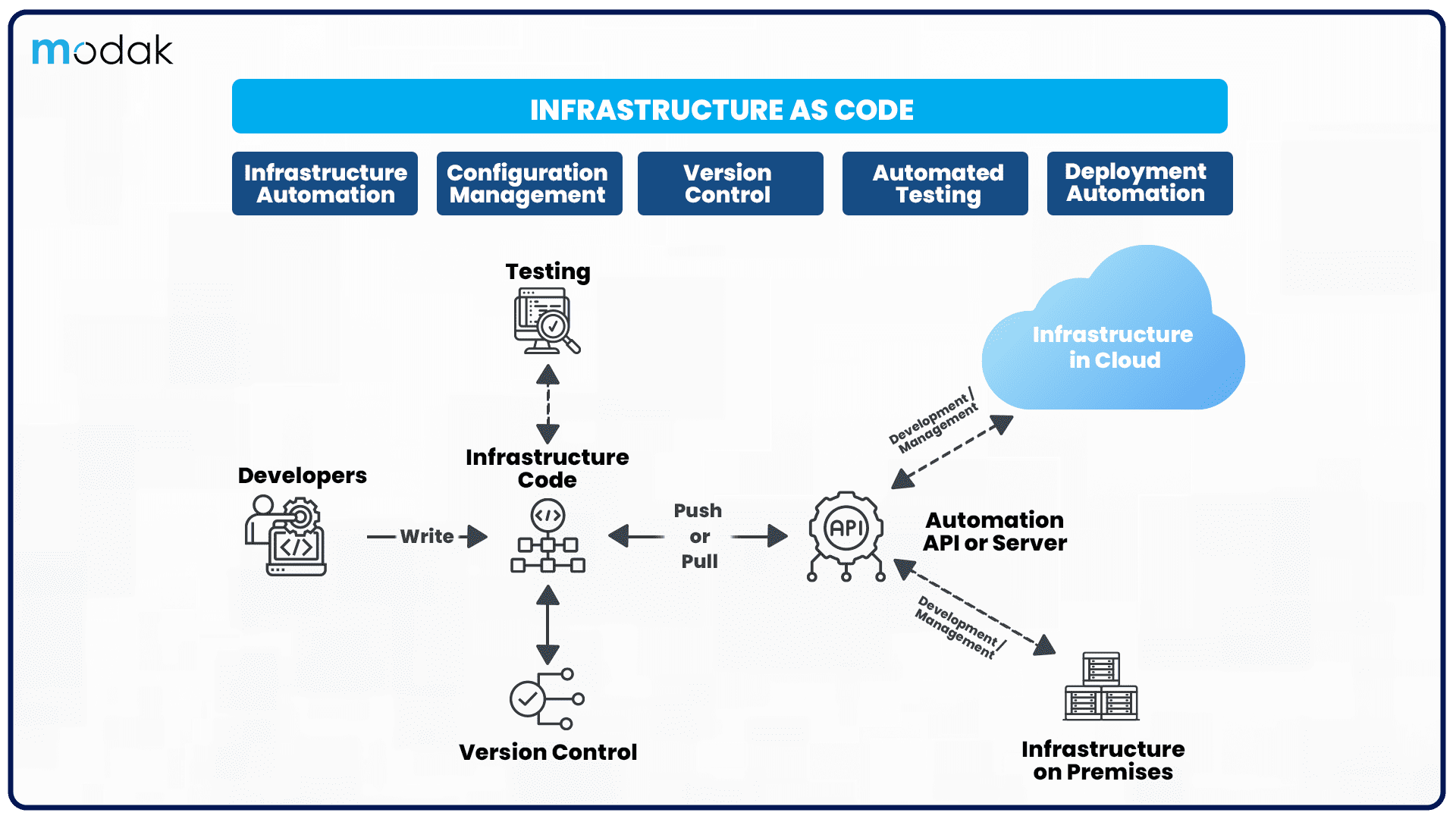In the rapidly evolving world of technology, businesses are perpetually on the lookout for methods to streamline operations and expedite software application delivery. Infrastructure as Code (IaC) emerges as a pivotal catalyst in this evolution. It empowers platform & manged services teams to handle and provision infrastructure using machine-readable definition files, ushering in an era of automation and efficiency which focuses on what truly matters & building, improving applications. IaC revolutionizes computing infrastructure management by employing code rather than manual configurations.
In every application environment, numerous infrastructure components, including cloud, operating systems, database connections, storage, and network, play a crucial role. However, traditional manual setup and maintenance are not only time-intensive but also error-prone, especially at scale.
With IaC, developers define the desired state of their infrastructure through code, automating the management process. This shift allows developers to devote more time to enhancing applications rather than navigating environmental complexities. By leveraging IaC, organizations streamline operations, mitigate risks, and swiftly adapt to evolving business landscapes, all while optimizing costs.
Understanding Infrastructure as Code:
By treating infrastructure as code, organizations can apply software engineering practices such as version control, automated testing, and continuous integration/continuous deployment (CI/CD) to infrastructure management, resulting in increased efficiency, consistency, and reliability.

Aspects of IaC are as the following:
- Infrastructure Automation: With IaC, DevOps teams can define infrastructure resources such as servers, networks, and storage using code, enabling rapid and consistent deployment of environments. This automation streamlines operations enhances efficiency and reduces manual errors in managing infrastructure.
- Version Control: Infrastructure code can be version-controlled using tools like Git, enabling teams to track changes, collaborate more effectively, and roll back to previous configurations if needed.
- Configuration Management: It encompasses tasks such as installing software, configuring settings, and managing system resources to ensure consistency and reliability across environments. With configuration management, DevOps teams can automate the provisioning and configuration of infrastructure resources, ensuring that they adhere to predefined standards and requirements.
- Automated Testing: By defining infrastructure as code, teams can automate the deployment and configuration of resources, reducing manual effort and minimizing the risk of human error.
- Deployment Management: With deployment management, DevOps teams can ensure consistency and reliability in the deployment process, minimize manual errors, and streamline the release cycle. By automating deployment tasks using IaC tools and practices, organizations can achieve faster and more reliable deployments, reduce downtime, and improve overall efficiency in software delivery pipelines.
By embracing IaC, organizations can revolutionize their approach to infrastructure management, unlocking developer productivity, ensuring consistent and reliable environments, and ultimately, accelerating their journey towards agility and innovation.
Benefits of IaC
The benefits of IaC are far-reaching such as:
- Enhanced Efficiency: IaC streamlines DevOps workflows by automating repetitive tasks like infrastructure provisioning and configuration.
- Cost-Efficient Operations: IaC eliminates manual processes and optimizes resource allocation, resulting in significant cost savings for organizations.
- Facilitated Collaboration: Infrastructure code in IaC formats, such as YAML or JSON, promotes seamless collaboration among team members.
- Robust Disaster Recovery: With IaC, infrastructure configurations are documented as code, simplifying disaster recovery processes. In the event of system failures or disasters, organizations can quickly rebuild or restore infrastructure using predefined code templates.
- Agile Deployment Practices: IaC empowers organizations to embrace agile development methodologies by enabling rapid experimentation and iteration. With infrastructure changes made programmatically, teams can accelerate the deployment of applications and features, reducing time-to-market.
- Consistent Deployments: IaC ensures consistency in infrastructure configurations across various environments, leading to reliable and predictable deployments. This consistency minimizes deployment errors and enhances overall system reliability.
- Scalability on Demand: Leveraging IaC, organizations can easily scale their infrastructure up or down to meet fluctuating demand. This scalability feature allows businesses to efficiently adapt to changing requirements and maintain optimal performance.
- Enhanced Security Measures: By codifying security best practices into automated checks and validations, IaC strengthens infrastructure security. Storing infrastructure code in version control systems enables security teams to monitor changes, audit configurations, and ensure compliance with industry standards.
IaC empowers developers to define their desired infrastructure state through code. This code then automates the entire provisioning and management process, freeing developers from the shackles of manual intervention.
Different Approaches to IaC
Declarative Approach:
The declarative approach to IaC revolves around defining the desired state of the system using configuration files or scripts. These specifications outline the resources required and their desired properties (Security), allowing IaC tools to automatically configure the infrastructure accordingly. One key benefit of the declarative approach is its simplicity in defining the desired state without specifying the step-by-step process of achieving it. Additionally, by maintaining a record of the system's current state, managing, and updating infrastructure becomes more straightforward, as the IaC tool can accurately track and apply changes.
Imperative Approach:
In contrast, the imperative approach to IaC focuses on detailing the specific commands or actions necessary to achieve the desired configuration. Instead of defining the end state, users must explicitly outline the sequence of commands required to provision, configure, and manage the infrastructure. While this approach offers granular control over the configuration process, it often involves more manual intervention and requires users to manage the execution order of commands. Consequently, imperative IaC tools may require additional effort to accommodate changes to the desired state, as users must determine how these changes should be implemented.
Considerations and Tool Preferences:
Many IaC tools support both declarative and imperative approaches, offering flexibility to users based on their preferences and requirements. However, some tools may lean towards one approach over the other, influencing the user experience and workflow. Declarative IaC tools excel in automating the provisioning and management of infrastructure based on predefined specifications, making them well-suited for environments with dynamic requirements and frequent updates. On the other hand, imperative IaC tools provide finer control and customization options, appealing to users who prioritize manual intervention and precise configuration management.
Understanding the nuances between declarative and imperative approaches to IaC is essential for organizations seeking to optimize their infrastructure management processes. By evaluating the strengths and weaknesses of each approach and aligning them with their specific use cases and preferences, organizations can effectively harness the power of Infrastructure as Code to streamline operations and drive innovation.
Conclusion:
In the dynamic world of modern applications, Infrastructure as Code (IaC) emerges as a game-changer, replacing the toil of manual configuration with the power of code. It empowers developers, streamlines operations, and unlocks organizational agility. By embracing IaC and its diverse approaches, organizations can transform their infrastructure management – from a complex labyrinth to an efficient and adaptable symphony, playing in perfect harmony with the application development cycle.
About Modak
Modak is a solutions company dedicated to empowering enterprises in effectively managing and harnessing their data landscape. They offer a technology, cloud, and vendor-agnostic approach to customer datafication initiatives. Leveraging machine learning (ML) techniques, Modak revolutionizes the way both structured and unstructured data are processed, utilized, and shared.
Modak has led multiple customers in reducing their time to value by 5x through Modak’s unique combination of data accelerators, deep data engineering expertise, and delivery methodology to enable multi-year digital transformation. To learn more visit or follow us on LinkedIn and Twitter.


